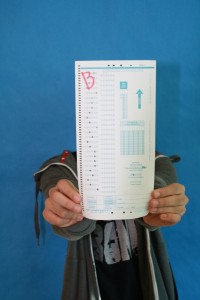Ross Gordon ’11 and
Jesse Heussner ’11
News Editor and Features Editor
Vinny Amaru ’11 studied his Advanced Placement (AP) US History textbook for weeks. Disregarding all distractions from families and friends, Amaru began to review the history of America until late into the night. He was rewarded with a grade above the average: an 85-percent.
He received no curve.
Similar to Amaru, Chenchen Feng ’11 studied for her AP Calculus BC midterm and received one of the better raw scores in the class: a solid “B.” However, unlike Amaru, her official grade would be boosted to an “A” thanks to a curve.
“I feel like I deserved the ‘A’ because I knew the material well enough that the teacher also believed the score was worth an ‘A,’ ” she said. “It’s about the demonstration of knowledge.”
The curving policy at Staples is not uniform across the core subjects. While AP English and social studies courses generally do not curve tests, AP science and math classes often do.
Curving at Staples has taken a different form than that of customary practice. A traditional bell curve sets a class average to a “C” and distributes an equal number of students above and below that set average.
At Staples, however, grades are either only curved up (where the lower test scores receive more of a boost than those at the top), or scaled, in which every student receives the same percentage point increase.
What’s most confusing, though, students said, is the discrepancy in policy between different departments. English 6-12 Coordinator Lis Comm addressed this discrepancy, acknowledging that AP English courses do not receive any curves.
“Our revision policy shows our concern for students’ grades,” Comm said.
English teachers do not curve scores because, Comm feels, the essay revision process gives students an opportunity to raise their grades that is similar to that that would be offered by a curve.
Comm also noted that while in-class AP prompt essays are not curved and cannot be revised, they are graded holistically and are not marked down for minor errors, giving students further leeway in improving their writing scores.
However, teachers do look for strong organization and support in these essays, just as they are scored on the official AP tests.
Like AP English, most AP social studies classes use essays in addition to tests when assessing students.
It is the department’s belief that since teachers have control of the questions on their tests, that students should have all of the required knowledge to do well. This is not the case on the AP exam, where there may be some concepts that students have not been exposed to prior to testing.
“My belief is to not curve. I believe your grade should be what you learned against a criteria,” Social Studies 6-12 Coordinator James D’Amico said. “I’m against scaling too. I’m not going to give points [to students] because then that’s an artificial average.”
Caela McCann ’11, who is enrolled in AP English Language, Environmental Science and U.S. History, feels that the lack of a curve in her English and social studies classes may have a negative effect on her GPA.
However, she recognizes that this benefits her work ethic.
“I work harder to get that ‘A’ because it isn’t padded by a curve,” McCann said. “I suppose it makes me a better student.”
Todd Lubin ’11, a student enrolled in AP Calculus BC, Chemistry and Economics, agrees with McCann and says that not having a curve will force students to study harder.
“Without a curve, students will have more incentive to study and do better on tests knowing that they will not have a curve to save them,” Lubin said.
Teachers of AP math and science courses say they use curves to align their personal exams with that of the AP exam administered by the College Board. Because teachers acknowledge the difficulty of the AP exam, they use the curve to give tougher tests that won’t result in low averages.
AP Statistics teacher Bill Walsh uses a mathematical approach to align his test grades with those of the AP Statistics exam. Walsh designs a logarithmic function to determine the curved grades of his class. The severity of the curve is based on what Walsh sees fit given the difficulty of the test and the prior knowledge that students have of AP Statistics.
“AP Stat tests are curved so that kids on the bottom are helped more than the kids on the top,” Walsh said. “I have to guess where it [the curve] needs to be.”
That curve, according to Math 6-12 Coordinator Frank Corbo, benefits AP students more than any other system. The bell curve, he believes, doesn’t work in AP classes because AP students are “homogeneous” and receive similarly high scores.
Science 6-12 Coordinator A.J. Scheetz and Corbo both think that teachers should be basing their tests off of the AP curriculum set by the College Board.
According to Corbo, any student who receives a final grade of an “A” in an AP math class should receive a “5” on the AP exam.
Likewise, any student who receives a final grade of a “C” in the class should ideally receive a “3” on the AP exam.
To match the final grades with the way they would translate on the AP exam, Corbo and Scheetz say that curves need to be used.
While the English and social studies departments want the same results, they believe that curving is not necessary because their tests can accurately gage a student’s ability without a curve.
All 6-12 coordinators strive for the same goal when creating a test: properly assessing a student’s knowledge of the curriculum.
“The bottom line is to focus on what the underlying goal of what giving a test is. The [grade] distribution is less of an issue,” Scheetz said.













































